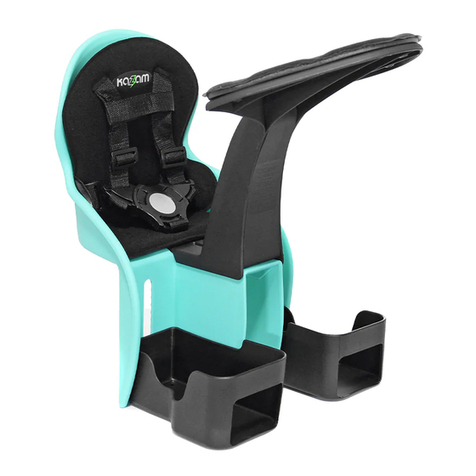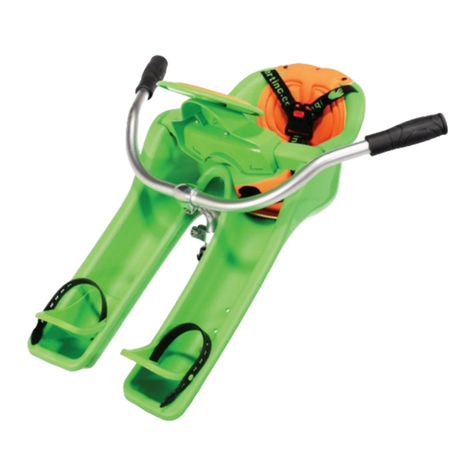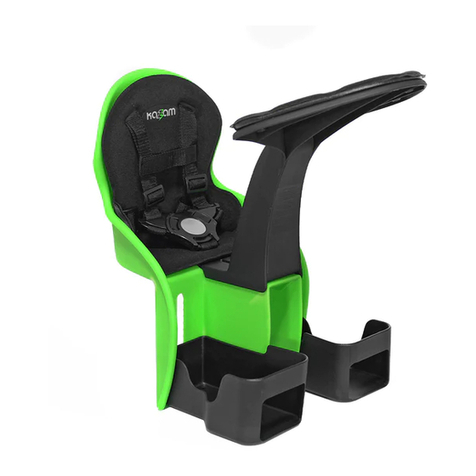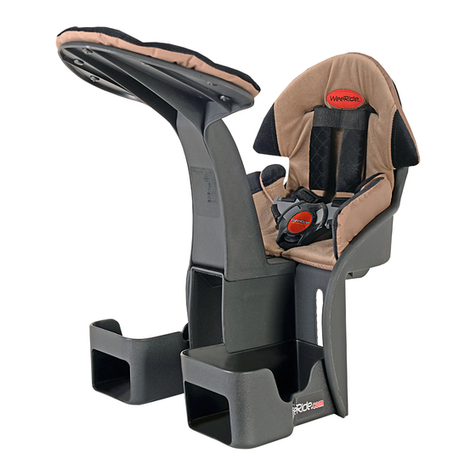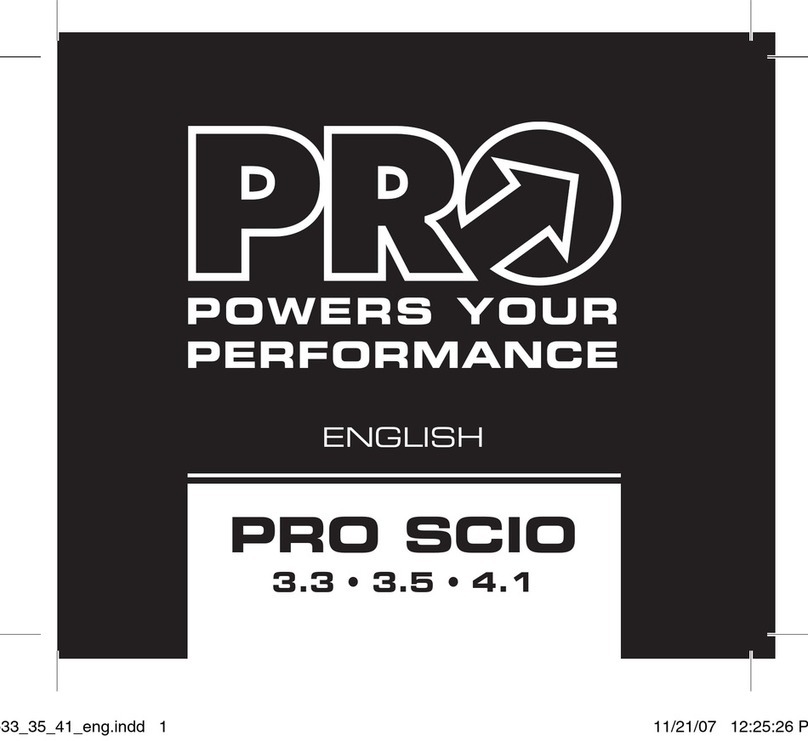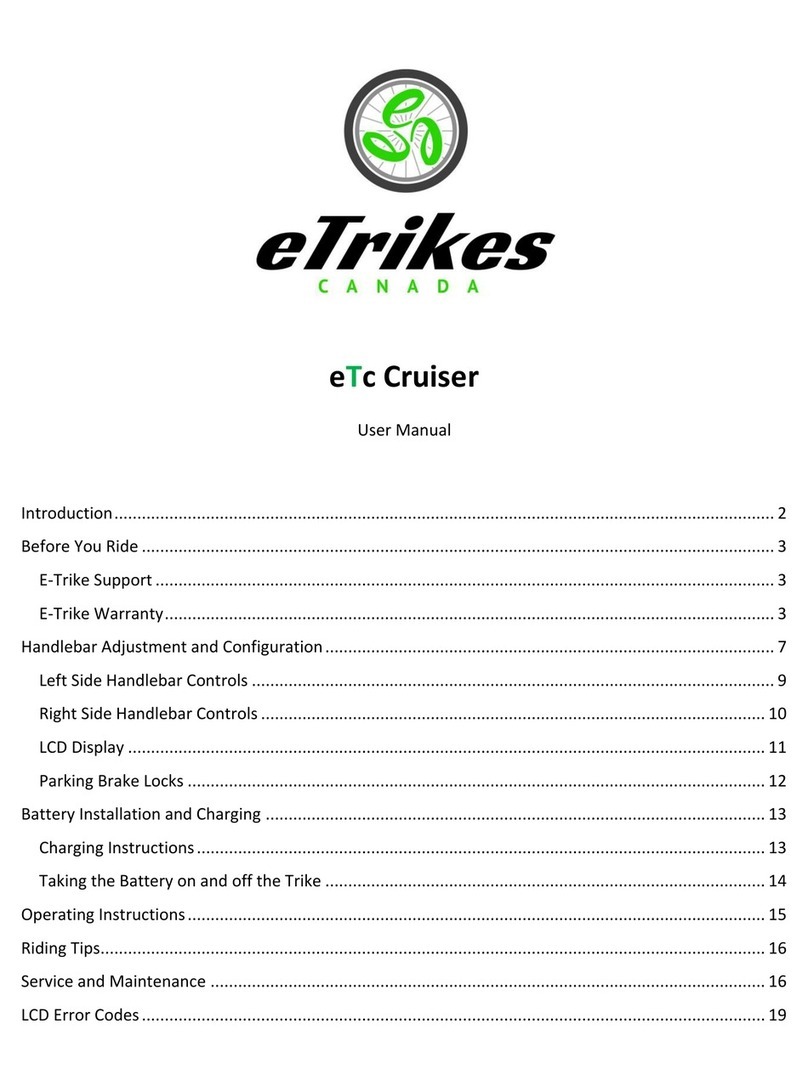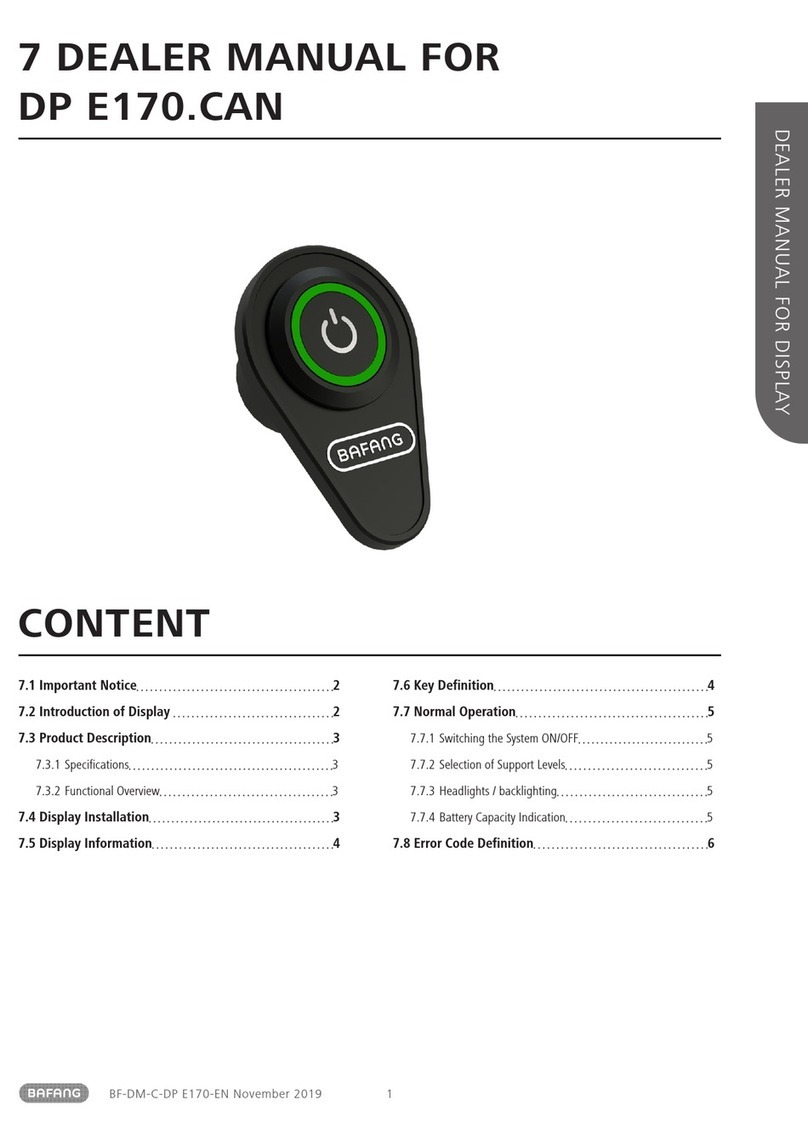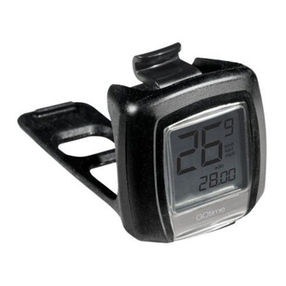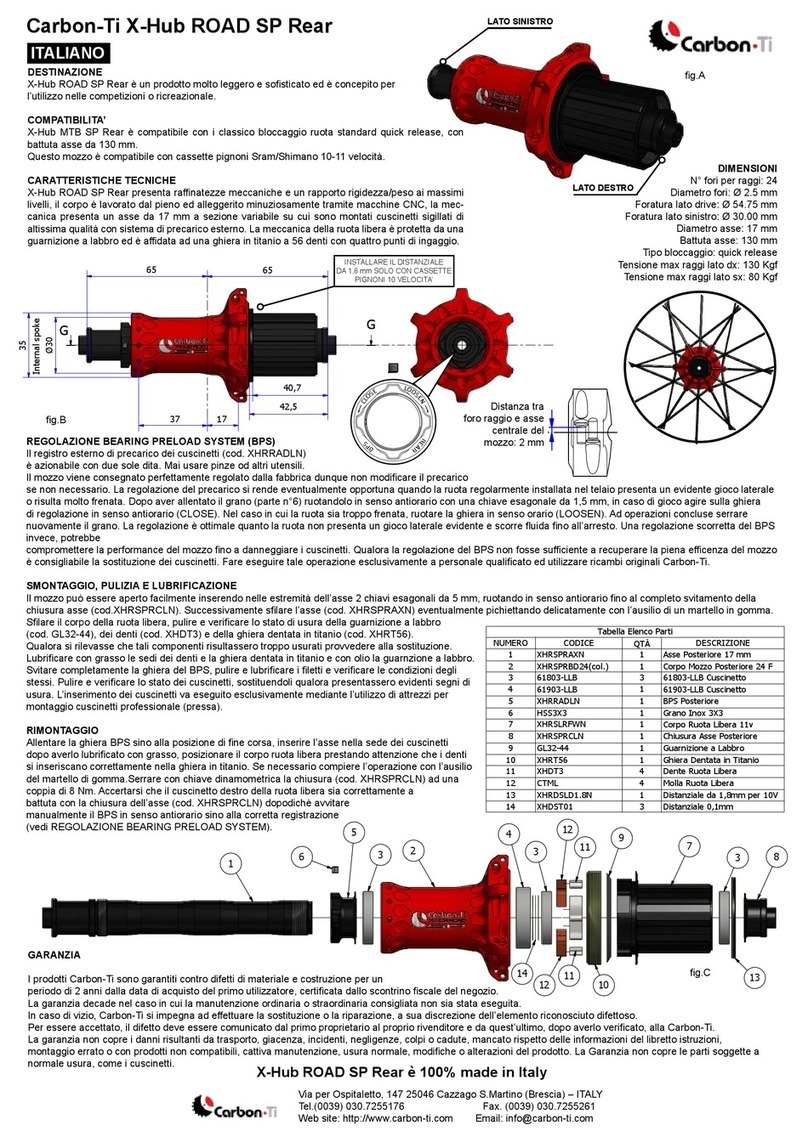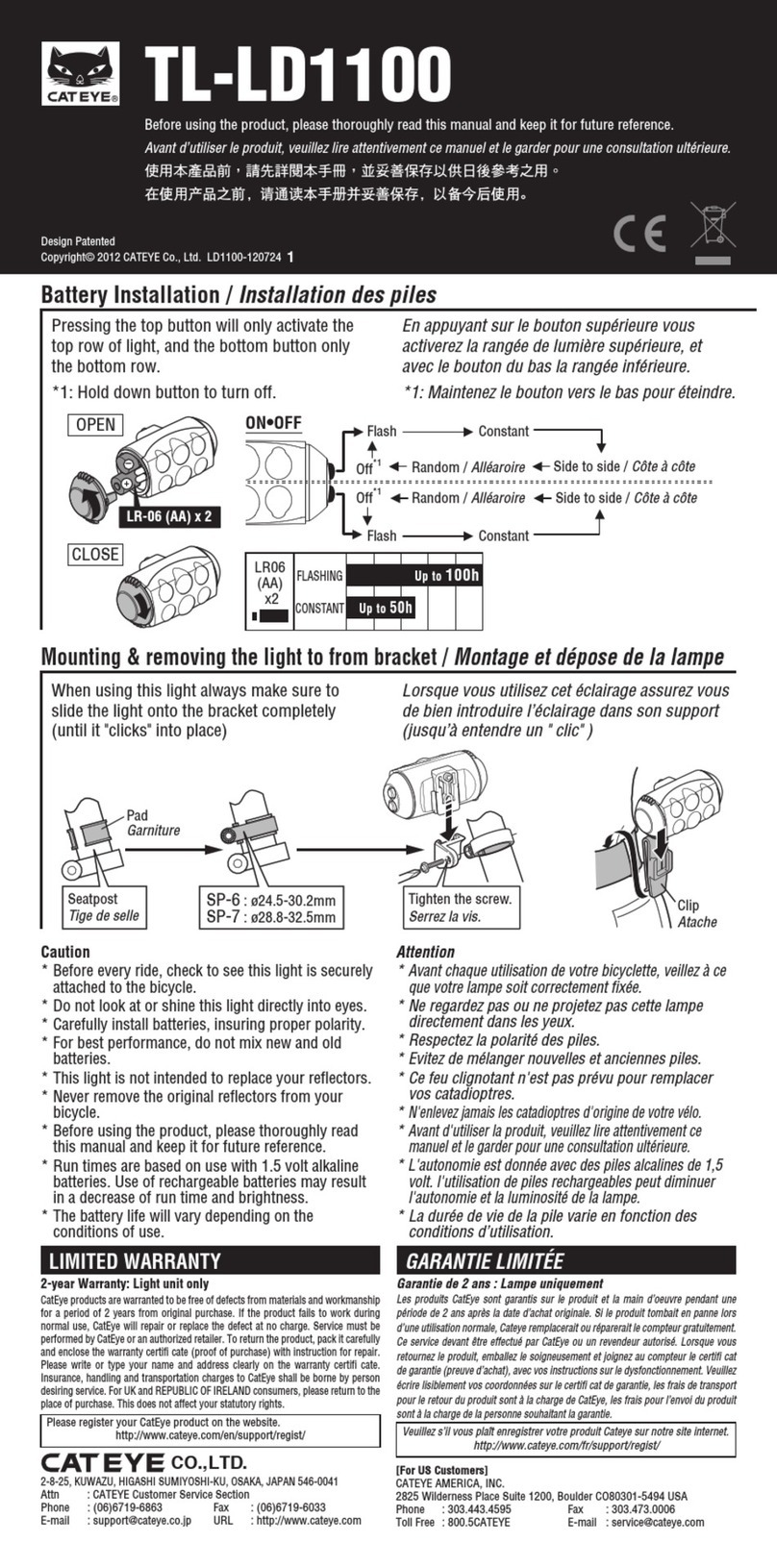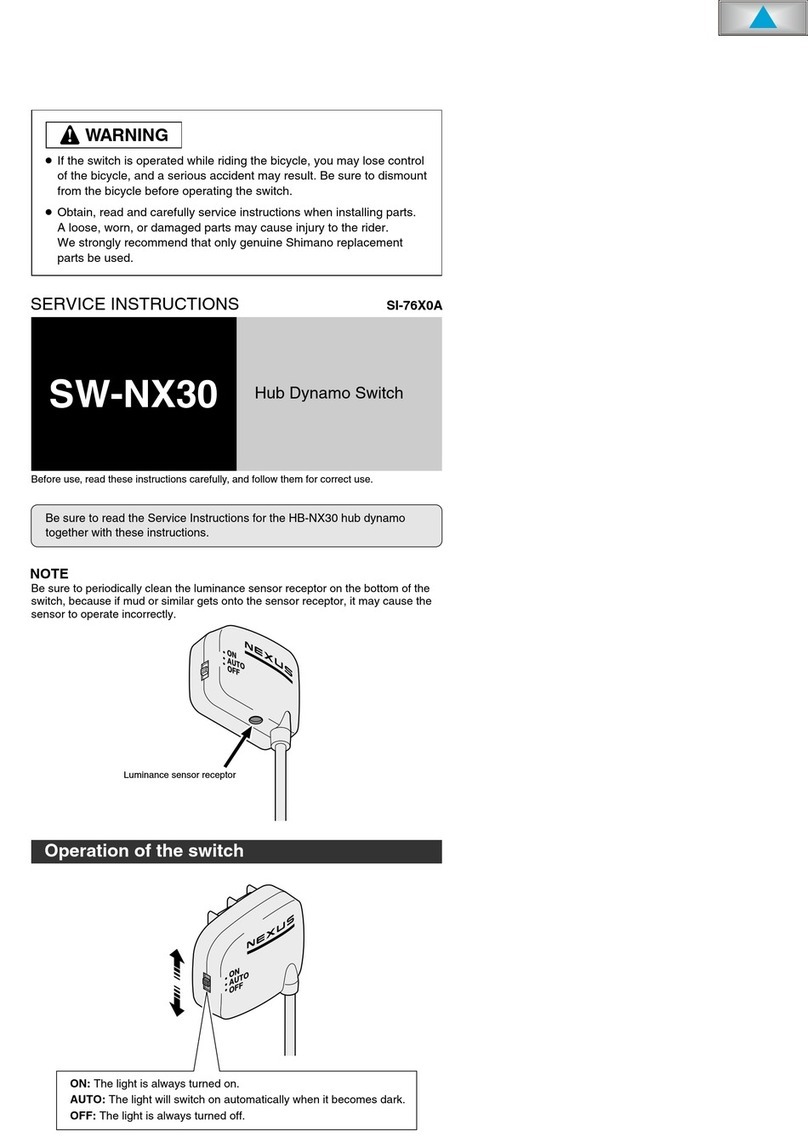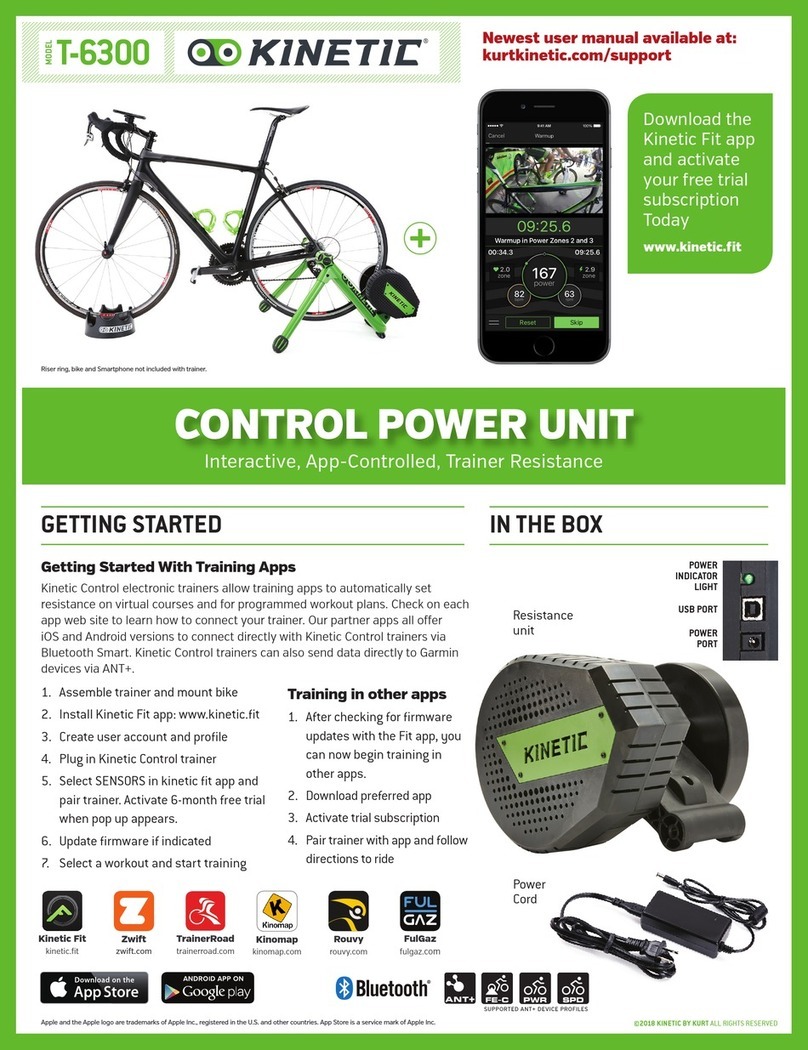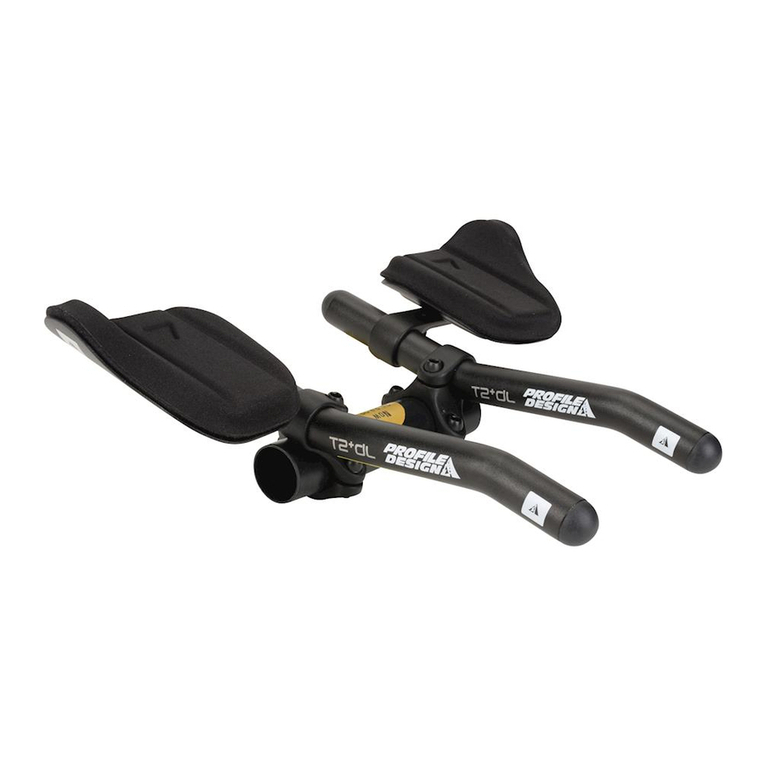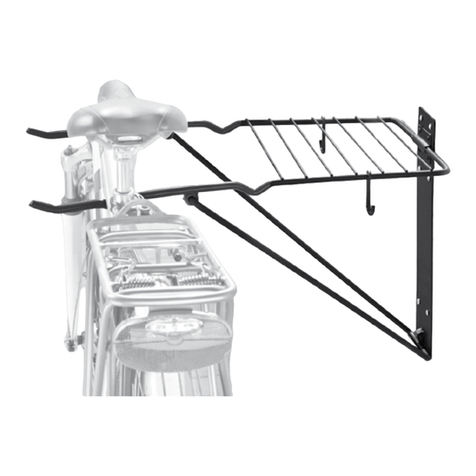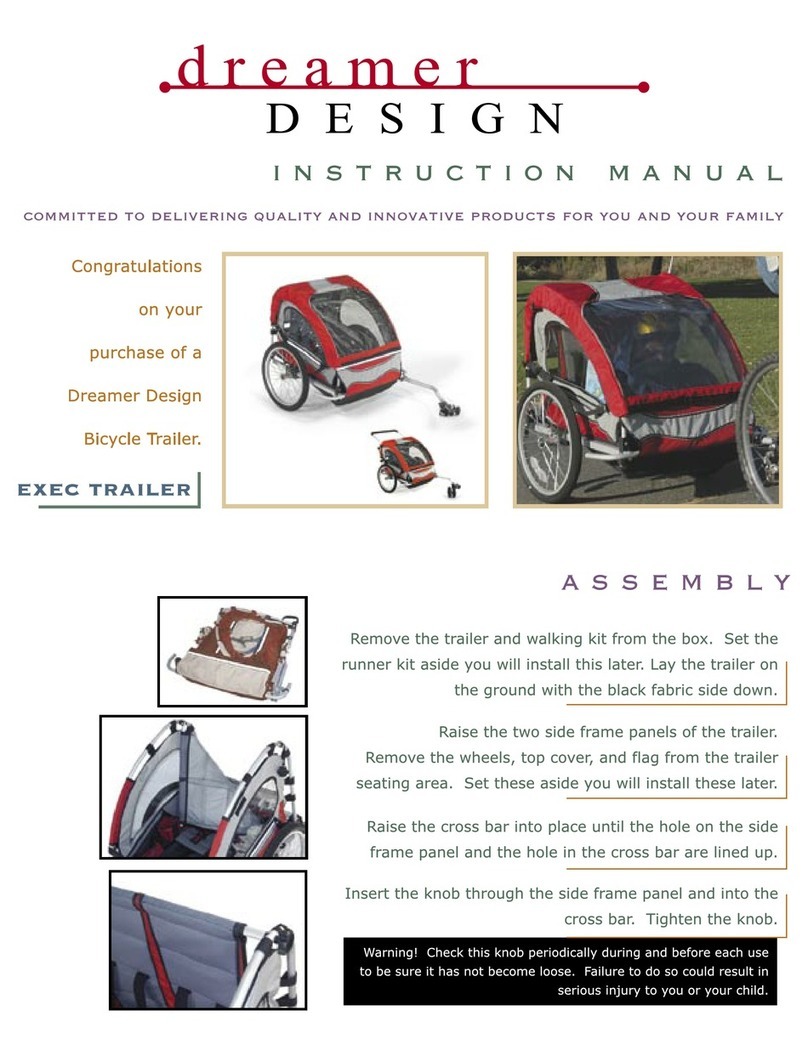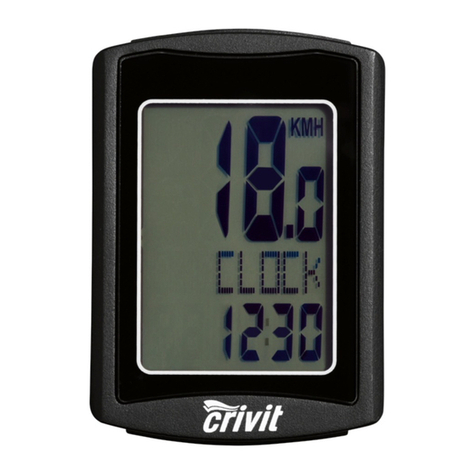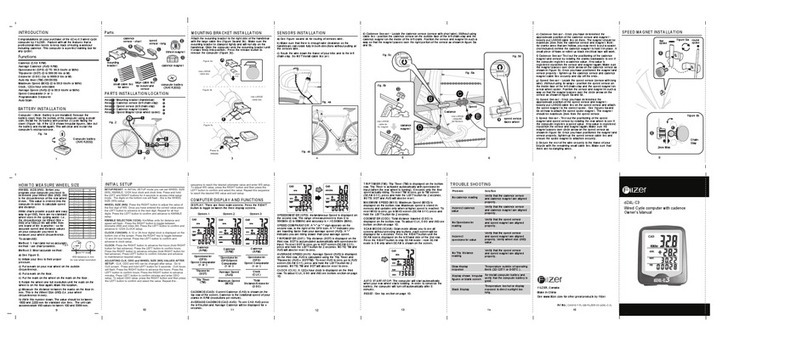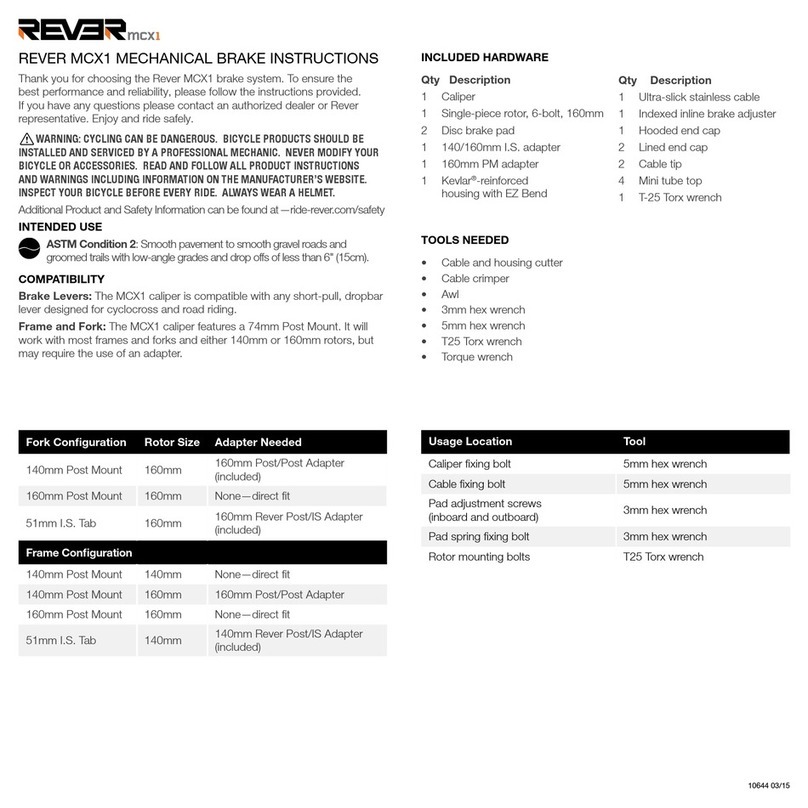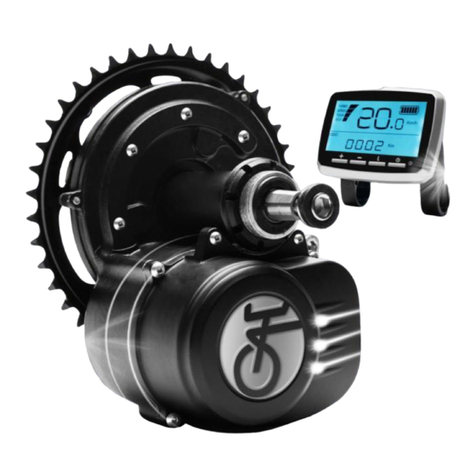KaZAM WeeRide Co-Pilot User manual

THIS INSTRUCTION BOOKLET CONTAINS IMPORTANT SAFETY, ASSEMBLY, USE,
AND MAINTENANCE INFORMATION. PLEASE READ AND KEEP FOR FUTURE REFERENCE.
T
CO-PILOT ASSEMBLY
Trailer Bike
BY

FOR SERVICE ASSISTANCE
CALL TOLL FREE 1.800.451.5368
Monday - Friday 8:00 a.m. to 4:00 p.m. Eastern Standard Time
Congratulations on the purchase of your new Co-Pilot! With proper assembly and maintenance it will offer your family years of
enjoyable riding!
IMPORTANT:
Carefully read and follow this manual (and any other materials included with this model) before riding. Please retain this manual
for future use. It is the responsibility of the purchaser to verify the Co-Pilot has been properly assembled, and that the user has been
properly trained and instructed in use of the Co-Pilot.
This manual is provided to assist you and is not intended to be a comprehensive manual covering all aspects of using, maintaining
and repairing your Co-Pilot. The model you have purchased is a complex piece of equipment that must be properly assembled and
maintained in order to be ridden safely. If you have any doubts about the assembly or your ability to properly assemble and
maintain the Co-Pilot or the lead bicycle being used, you must have it assembled and maintained by a professional bicycle
mechanic.
DANGER! Failure to properly assemble and maintain your bicycle and this Co-Pilot could result in serious injury
or death to the rider(s).
ATTENTION BICYCLE AND CO-PILOT RIDERS:
ALWAYS WEAR A PROPERLY FITTED HELMET
WHEN YOU RIDE. DO NOT RIDE AT NIGHT.
AVOID RIDING IN WET CONDITIONS.
Check and read this decal on
your Co-Pilot before each ride:

RESPONSIBILITY OF THE OWNER!
IMPORTANT: Reading and following the information and instructions in this manual are essential to the ability to ride safely.
1. It is the responsibility of the owner or in the case of a younger rider the parents of the rider to be certain all assembly instructions have been followed,
even if the bike has been assembled by the seller or a professional assembly company.
2. Rules for bicycle use (bicycle laws) vary from location to location so be certain the rider knows and understands the rules that apply to bicycle usage in
your area. Wearing a helmet and using lights and reflectors are two examples of rules which probably exist and which make sense as rider safety precautions
at all times and in all locations.
3. Know how to operate the bicycle with the Co-Pilot attached and all equipment on it before first use and be certain anyone else allowed to use the bike
knows how to properly and safely use the bike as well.
Any major service or adjustments on your model should be carried out by a competent adult or professional bike mechanic. If you wish to make
adujstments yourself, this manual contains important tips on how to do it. CAUTION: Any adjustments you make are entirely at your own risk.
Do NOT use your Co-Pilot for freestyle and stunt riding, jumping or competitive events. Even if you are riding a mountain bike, you should know
that off-road use or any similar activities can be dangerous, and you are warned that you assume the risk for personal injury, damages or losses to the
bike and/or Co-Pilot incurred from such use. Do not ride your bike and/or Co-Pilot when any part is damaged or not working properly. If you are unsure
how to carry out repairs or maintenance on your Co-Pilot, it is vital that you promptly consult a local bike mechanic for professional assistance and support.
WARNING: As with all mechanical components, the bicycle and this model are subjected to wear and high stresses. Different materials and
components may react to wear or stress or fatigue in different ways. If the design life of a component has been exceeded, it may suddenly fail,
possibly causing injuries to the rider (s). Any form of crack, scratches or change of coloring in highly stressed areas indicate that the life of the
component has been reached and should be replaced.
Forehead covered Forehead exposed
ALWAYS WEAR A HELMET-
IT COULD SAVE YOUR LIFE!
A properly fitting, CPSC approved, bicycle helmet should be worn
at all times when riding your bicycle and/or Co-Pilot. In addition, if you
are carrying a passenger on the Co-Pilot model remember the
passenger must also be wearing a helmet.
The correct helmet should:
– be comfortable
– be lightweight
– have good ventilation
– fit correctly
– cover the forehead
– be securely fastened on the rider
3

IMPORTANT: Use this Diagram when reading this manual
to help you understand directions and instructions.
PARTS IDENTIFICATION
Seat
Seat Post
Reflector
Chainwheel
Pedal
Spokes
Seat Post
Clamp
Rim
Tire
Chainguard
Crank Arm
Stem
Trailer Mount
Folding Mechanism
Grips
Handlebar
Flag
Wheel
Reflector
4

RULES OF THE ROAD
In the interest of safe cycling, make sure you read and understand the bike ownerr’s manual and the Co-Pilot assembly manual.
DANGER, WARNING , CAUTION, IMPORTANT, and NOTE or NOTICE. These are important
signal words telling you to pay special attention to that text as rider safety is involved. DANGER and WARNING: Pay special
attention to these since failure to do so could result in serious injury or death to the rider(s) or others.
CAUTION: If not followed these instructions could result in injury or mechanical failure or damage to the bicycle and Co-Pilot .
NOTE or NOTICE or IMPORTANT: These specify something that is of special interest.
IMPORTANT Before you ride bicycle with Co-Pilot attached, read this RULES OF THE ROAD section and check that all parts
are installed and working as per this manual. If you understand how the bicycle and Co-Pilot operates, you will get the best performance.
When you read this instruction book, compare the illustrations to the bicycle and Co-Pilot. Learn the location of all the parts and how
they work. Keep this book for future reference.
CAUTION: Before you ride, make sure all parts are tightened, assembled correctly and working properly. Take your first ride in a large
open level area without a passenger. If you have a problem, check the assembly instructions and follow the maintenance procedures
in this book. If you do not feel comfortable with your skills in assembling, adjusting or operating the bike with the Co-Pilot attached,
please take it to a professional bike repairman for help.
1. WARNING - ON AND OFF ROAD CONDITIONS: The condition of the riding surface is very important. If the surface is wet, or
has sand, leaves, small rocks or other loose debris on the surface where you plan to ride, carefully decrease the speed of the bicycle and
ride with extra caution. It will also take a longer time and more distance to stop. Apply the brake earlier than normal and with less force,
rear brake first followed by the front brake if equipped, to help keep the bicycle and Co-Pilot from sliding, falling, or jackknifing. Avoid
sharp turns.
3. Always wear shoes when riding a bicycle or the Co-Pilot and avoid loose fitting clothes. Wear a cuff band or trouser clip to keep
trousers from getting caught in the chainwheel. Long sleeves, long pants, gloves, eye protection, a good helmet, elbow and knee pads
are recommended. NOTE: a helmet may be required.
2. NOTICE: Some local laws may require that your bike be equipped with a warning device, such as a horn or bell or light. Do NOT
ride at night. Vision is quite limited at dawn, dusk and at night. If you must ride at night, take extra precautions, use front and rear lights,
wear flashers on your arms, wear light colored clothing, and plan your route to ride in well lighted areas. Make sure the flag and
reflectors are present and not covered.
5

RULES OF THE ROAD continued
4. CAUTION: WET WEATHER WARNING: Check your brakes frequently. The ability to stop is critical. Roads are slippery in wet
weather so avoid sharp turns and allow more distance for stopping. Brakes may become less efficient when wet. Leaves, loose gravel and
other debris on the road can also affect stopping distance. If at all possible, do not ride in wet weather. Vision and control are impaired,
creating a greater risk of accidents and injury. Remember the Co-Pilot unit and rider add extra weight that can also slow stopping.
5. CAUTION: A bicycle rider’s best defense against accidents is to be alert to road conditions and traffic in the area. Do not wear anything
that restricts your vision or your hearing. Be alert for hazards and motorists at all times.
6. When riding, ALWAYS WEAR AN APPROVED BIKE HELMET.
7. Obey all traffic regulations. Most traffic regulations apply to bike riders as well as automobile operators. Observe all local traffic
regulations, signs and signals. Check with your local police station on bicycle licensing and inspection which is required in some places
as well as where it is legal to ride your bike.
8. Follow the traffic flow in a straight line close to the curb. Watch out for opening car doors, cars moving in and out of traffic, and cars
exiting driveways. Use caution at intersections and keep both hands on the handlebars.
9. Never carry passengers unless in an approved child carrier or in the Co-Pilot unit. This is dangerous and it makes the bicycle harder to
control. Never carry packages that can hinder your vision or control of the bike.
10. When riding in pairs or in larger groups, form a single line along the right side of the road. Set up a sensible distance between riders.
Do not follow too closely.
11. Maintain a safe riding speed at all times, including during straight paths, curves, and turns. Maximum recommended riding speed
is 5mph (8km/h).
12. Always be alert. Animals or people may dart in front of you. Give pedestrians the right-of-way. Don’t ride too close to pedestrians, and
don’t park your bicycle where it can get in the way of foot/vehicle traffic.
13. Be careful at all crossroads. Slow down and look both ways before crossing.
14. Use hand signals. Always let other drivers and pedestrians know what you are going to do. Signal 100 ft. before turning unless your
hand is needed to control the bike. Always ride at a slow reasonable and safe speed slowing significantly during turns.
15. WARNING: NIGHT TIME OPERATION: We do NOT recommend riding your bike at night. If you have an emergency that requires
you to ride at night, you must have proper lights and reflectors. NEVER ride at night without a headlight, taillight, a white front reflector,
a red rear reflector, pedal reflectors and white wheel reflectors. Also wear light color clothes to improve visibility to others.
6

RULES OF THE ROAD
16. Cover the stem, handlebar, and top tube of the bike and Co-Pilot with safety pads for additional protection when riding on rough surfaces.
17. Never hitch rides. Never hold onto moving vehicles while riding. Never stunt ride or jump on your bike, especially when the Co-Pilot
is attached.
18. ON AND OFF ROAD OPERATION: Avoid the following road hazards: drain grates, pot holes, ruts, soft road edges, gravel, leaves
(especially when they are wet), uneven or broken pavement, railroad crossings, manhole covers, curbs, speed bumps, puddles, and debris.
All of these can have an effect on your riding and may result in loss of control.
19. Do NOT ride your bicycle or use the Co-Pilot if the chain cover is not attached.
20. CAUTION: Any load added to a bicycle will lessen the stability of the bicycle and alter its riding characteristics. Do not attempt to
carry a load that is heavier than you can readily control. Match the load to your weight, size, and strength.
COMPATIBILITY:
• This model is designed to fit and attach securely to most adult bicycles using a wheel size of 26” (mountain bike size), 27” or 700C.
It should not be fitted to bicycles with 20” or 24” wheels, as they may not have enough pedal clearance between the Co-Pilot’s pedals
and the ground when leaning or turning. The lead bicycle should only be operated by an adult.
• It is recommended that the minimum height from the ground to the bottom of the hitch assembly is 76cm or 30” or 7.5cm or 3.5”
between the bottom of the hitch and the rear tire of the towing bicycle. This same clearance should be kept if using a fender or
pannier rack. This will ensure proper clearance for the Co-Pilot’s pedals when cornering as well as clearance for the lead bicycle’s
rear tire, rear fender, or rack under the hitch arm.
• Before mounting this model, check the lead bike to verify all parts, including brakes, are in good working condition. Verify all
parts are free of cracks and are not damaged or deformed.
• We recommend using only a high quality chromoly seat post to tow the Co-Pilot. Seat posts made of thin alloy, steel, aluminum,
or carbon fiber could bend or break under the added weight.
Weight Limit: (Max. weight of rider=75lbs/34kg, weight of adult rider for lead bicycle should be at least twice the weight of the passenger.)
These Co-Pilot models are intended for use in safe areas with riding surfaces that are in good condition and free of traffic. Children must know
how to ride within their abilities and do so under adult supervision. Rider and passenger should both wear a safety helmet and use other safety
equipment at all times. An adult should check the lead bike and Co-Pilot unit regularly and do required maintenance. Do not exceed
recommended weight limits as this may result in injury. WE DO NOT RECOMMEND RIDING WITH CHILDREN WHO ARE NOT
ALREADY ABLE TO RIDE ON A SMALLER BICYCLE WITH OR WITHOUT TRAINING WHEELS.
continued
7

BEFORE RIDING:
Your new Co-Pilot was assembled and tuned in the factory and then partially disassembled for shipping. The following instructions will
enable you to prepare your Co-Pilot for years of enjoyable cycling. For more details on inspection, lubrication, maintenance and adjustment
of any area please refer to the relevant sections in this manual. If you have questions about your ability to properly assemble this model,
please consult a professional bicycle mechanic before riding.
Just a minute spent before each ride can significantly improve your safety and the enjoyment of your ride. So, each time before you
ride make a habit of performing the following safety checks on the Co-Pilot and the bicycle to which it is attached.
• Try to lift, push down on and twist the seat to confirm that it is tight.
• Look at the connection of the pedals to the crank arm. You should see no pedal screw threads and the pedal should feel firm and
be parallel to the ground.
• Apply your bike brake(s) and make sure that they feel firm to the touch, and then spin the wheel(s). Apply the brake(s). They should
stop the wheel(s).
• Check to be sure that fenders and accessories are firmly attached and will not contact any moving parts. Make sure all reflectors are
in position and not broken or missing. Replace any broken or missing reflectors before riding.
After you and your rider have put on your bicycle safety helmets, go enjoy your ride. Your safety and that of your passenger
is well worth just a minute. Also, be sure to read and follow the warnings and instructions on the bicycle and in the Assembly,
Maintenance and other sections of this manual.
TO AVOID INJURY, THIS PRODUCT MUST BE PROPERLY ASSEMBLED BEFORE USE. WE STRONGLY
RECOMMEND THAT YOU REVIEW THE COMPLETE ASSEMBLY GUIDE AND PERFORM CHECKS
SPECIFIED IN THE OWNER’S MANUAL BEFORE RIDING.
• 5/6mm hex wrench
• Torque wrench
• Bicycle lubricant or grease
• 6” adjustable wrench
• Phillips & standard screwdrivers
• A pair of pliers with cable cutting ability
8
BEFORE EVERY RIDE:

9
BEFORE RIDING:
CAUTION: Added weight from the Co-Pilot unit, plus its passenger if applicable, will affect the riding and braking functions of the lead
bicycle. Before riding make sure your bicycle is in good working condition. Be aware that braking, stopping, and turning may take
longer or feel different due to extra load.
Remember that with a Co-Pilot attached to your bicycle, the unit is longer than before and the added weight will alter the stability
and riding characteristics.
• Turning and maneuvering may require more skill. Avoid extremely sharp turns while towing a Co-Pilot as it will be very
difficult to maneuver until you gain experience. Try to follow a smooth route; plan turns following a wide arc whenever possible.
• Take extra care to make your moves on the lead bicycle very slow and smooth. This will make it easier for the rider on the
Co-Pilot. Look far ahead in order to move straight and plan your route.
• Before riding, ensure the Co-Pilot unit does not hamper braking, pedaling, or steering of the lead bicycle.
WARNING: DO NOT ATTACH ADDITIONAL TRAILERS OR VEHICLES TO
THE REAR OF THE CO-PILOT UNIT.
FOR SAFETY REASONS WHILE RIDING MAKE SURE ALL LOOSE CLOTHING,
SHOE LACES, TOYS, AND/OR BODY PARTS OF DRIVER AND PASSENGER
REMAIN CLEAR OF ALL MOVING PARTS.

ASSEMBLY INSTRUCTIONS
STEP 1: HINGE ASSEMBLY
1. Grasp the lower frame (A) and rotate trailer arm (B) upwards until
the two flat plates meet and the alignment pin clicks securely into place.
2. Rotate the quick release lever over and down into the slot. Adjust
the quick release tension by rotating clockwise to tighten and
3. Before you proceed, check to be sure all parts are securely
fastened.
counter clockwise to loosen. Set the quick release lever to the
closed position.
1. HINGE CLOSED AND IN LOCK POSITION
TOP VIEW
TOP VIEW
2. ROTATE QUICK RELEASE DOWN TO UNLOCK
QUICK
RELEASE
LEVER
B
A
10

ASSEMBLY INSTRUCTIONS continued
STEP 2: HANDLEBAR ASSEMBLY
NOTE: The stem has been pre-assembled to the handlebar at the factory. Prior to
assembly, check to be certain the handlebar is securely fastened to the stem.
1. Insert the handlebar stem (C) into the frame tube with the clamp portion, which holds
the handlebar in place, toward the front. The stem must be inserted far enough into the
frame tube to hide the minimum insertion line marked on the stem. (If necessary,
loosen the expander bolt to allow the stem to fit into the fork tube.)
2. Place a drop of oil under the head of the expander bolt (D). Tighten the expander
bolt just enough to hold the stem in place.
3. Raise or lower the handlebar stem until you have reached the desired height for the
user of the Co-Pilot and then position the handlebar so it is perpendicular (90 degrees)
to the front of the bike. Next, tighten the expander bolt to the required torque. Be sure
to have inserted the handlebar steering tube at least 2 1/2” (65mm), making certain the
minimum insertion line is no longer visible. Torque 10-15 ft-lb / 13-20 N-m
WARNING: Assembler is cautioned against the danger of damaging the handlebar
stem assembly and possible injury to rider which can result from under-tightening
or over-tightening the expander bolt and expander wedge.
4. Slightly loosen the clamp bolts (E) to allow the handlebar (F) to
rotate easily. Rotate the handlebar into an upright position.
After you have achieved a comfortable handlebar position for the
intended user, then proceed to tighten all four clamp bolts to the
torque specified below. Tighten each bolt only a few turns at a time,
to get even clamping. Torque 8-11 ft-lb / 11-15 N-m
C
E
F
D
TOP VIEW
FRONT VIEW
11

ASSEMBLY INSTRUCTIONS continued
STEP 3: INSTALL SEAT AND SEAT POST
FOR YOUR CONVENIENCE THE SEAT ON SOME UNITS MAY HAVE
BEEN ASSEMBLED TO THE SEAT POST AT THE FACTORY.
SEAT ASSEMBLY:
1. Loosen seat clamp nut (G).
2. Insert the top portion of seat post (H) into
the seat clamp (I). Be sure the seat post is
completely inserted into the seat clamp and
butted tight against the end stop.
3. Retighten seat clamp nut on both sides (hand tight). The nut
will be securely tightened later with an adjustable wrench.
SEAT POST ASSEMBLY:
4. Insert seat post into bicycle frame. Be sure that seat post
is inserted into frame at least 2 1/2” (65mm).
CAUTION: MINIMUM INSERTION LINE SHOULD
BE COMPLETELY INSERTED INTO THE FRAME
AND NOT VISIBLE ONCE INSERTED.
5. Tighten the seat post binder bolt (J) securely at desired height to fit
the intended user.
6. Adjust angle of seat so that top of seat is parallel to the ground and
comfortable for the rider.
7. Retighten seat clamp securely with an adjustable wrench to the torque
specified below. PLEASE NOTE: Test the seat to pedal distance. The
ball of the foot of the intended rider should rest comfortably on the pedal
when it is in its lowest position. If it does not, adjust the seat height as necessary.
Check for tightness by attempting to move the seat up and down, then side to side. If the seat is loose, be sure to tighten the clamp nut
and binder bolt nut securely. Torque 12-16 ft-lb / 17-21 N-m
J
H
GI
12

ASSEMBLY INSTRUCTIONS continued
STEP 4: INSTALL PEDALS
WARNING: For safe operation, the pedal spindle must be securely tightened against the crank arm. Always replace damaged pedals, and
always wear shoes or sneakers when riding a bicycle.
NOTICE: Start each pedal spindle by hand to avoid stripping the threads.
1. Look for the letters “R” or “L” stamped on the end of the pedal spindle.
2. Thread the pedal marked “R” into the crank arm on the right or “chain side” of the bike. Turn the pedal spindle in a clockwise direction.
Securely tighten the pedal spindle with a wrench.
3. Thread the pedal marked “L” into the crank on the left side of the bike. Turn the pedal spindle in a COUNTER CLOCKWISE direction.
Securely tighten the pedal spindle with a wrench.
NOTE: Both pedals should be tightened towards the front of the bicycle.
Torque 15-18 ft-lb / 20-26 N-m
13

ASSEMBLY INSTRUCTIONS continued
STEP 5: ATTACH THE TRAILER MOUNT TO THE ADULT (LEAD) BICYCLE
CLAMP ATTACHMENT:
1. Loosen all 4 clamp bolts (K) and remove the front plate (L) from the trailer clamp.
2. Place the copilot mount behind the adult bike with the trailer clamp against the adult bike seat post (M). The seat post should rest in the
valley of the trailer mount.
3. Place the trailer mount plate over the front of the seat post and tighten all four bolts by hand. Tighten each bolt two complete turns with
an Allen wrench.
4. Tighten all four bolts in a crisscross pattern (1, 2, 3, 4 as shown below then repeat) until they are tightened equally and the gap between
the clamp plate and the mount is even on both sides.
K
M
1
L
3
4
2
14

ASSEMBLY INSTRUCTIONS continued
STEP 6: ATTACHING THE TRAILER TO THE BICYCLE
1. Insert the Co-Pilot arm (N) into the mount (O) on the adult bicycle and align the holes on each part.
2. Remove the nut from quick release pin and insert the pin into the mount and push it all the way through the hole.
3. Now thread the nut onto the pin until it makes contact with the mount. Check to see that the quick release lever (P) is in the open position.
4. Adjust the nut counter clockwise until the quick release will tighten to the closed position.
REMOVING THE CO-PILOT TRAILER BIKE
When you do not need the trailer bike attached, it is very simple to remove the bike without removing the trailer clamp.
1. Loosen the quick release lever (P) and remove the nut from the other side.
2. Slide the quick release bolt completely out.
3. Slide the Co-Pilot arm (N) out from the seat post mount (O). Replace the quick release pin and tighten.
NO
P
15

ASSEMBLY INSTRUCTIONS continued
STEP 7: INSTALL SAFETY FLAG
ALWAYS USE THE SAFETY FLAG
WHEN RIDING YOUR TRAILER BIKE.
1. Locate the safety flag, poles, and plastic joiner.
Join the two poles by inserting one pole into each
end of the joiner.
2. Insert the safety flag assembly into the bracket
next to the trailer bike’s rear hub nut.
3. The completed product should look as shown below.
16

OPERATING THE CO-PILOT TRAILER BIKE
Before riding, check the tire pressure and recheck all fasteners.
STORING THE CO-PILOT TRAILER BIKE
When not in use for an extended period of time, the Co-Pilot should be removed from the lead bicycle and safely stored indoors in a dry,
well-ventilated area away from elements which may compromise the reliability or structural integrity of the trailer. Remove the Co-Pilot
bike using the instructions as described on page 14.
NOTE: During storage the tire on the Co-Pilot unit may lose air, so always check tire pressure before riding and check all fasteners for
proper tightness.
WARNING: Always use the safety flag when riding with this product.
The adult should straddle the bike to hold it steady and upright while the child climbs onto the Co-Pilot.
WARNING! THE ADULT BIKE KICKSTAND IS NOT DESIGNED TO SUPPORT THE ADDITIONAL WEIGHT OF A CHILD
SEATED ON THE TRAILER BIKE. THE ADULT PULLING THE CHILD SHOULD ALWAYS STRADDLE THE ADULT BIKE
WHENEVER THE CHILD IS SEATED ON THE TRAILER BIKE, OR GETTING ON AND OFF THE TRAILER BIKE.
WARNING! Adult and child should always wear an approved safety helmet when riding! Do NOT ride at night.
17

18
REFLECTORS
WARNING! REFLECTORS ARE IMPORTANT SAFETY DEVICES WHICH ARE DESIGNED AS AN INTEGRAL
PART OF YOUR BICYCLE. FEDERAL REGULATIONS REQUIRE EVERY BICYCLE TO BE EQUIPPED WITH
FRONT, REAR, WHEEL, AND PEDAL REFLECTORS. THESE REFLECTORS ARE DESIGNED TO PICK UP AND
REFLECT STREET LIGHTS AND CAR LIGHTS IN A WAY THAT HELPS YOU TO BE SEEN AND RECOGNIZED AS
A MOVING BICYCLIST. CHECK REFLECTORS AND THEIR MOUNTING BRACKETS REGULARLY TO MAKE
SURE THEY ARE CLEAN, STRAIGHT, UNBROKEN AND SECURELY MOUNTED. HAVE YOUR DEALER REPLACE
DAMAGED REFLECTORS AND STRAIGHTEN OR TIGHTEN ANY THAT ARE BENT OR LOOSE.
Your Co-Pilot is supplied with a red rear reflector and a white wheel reflector as well as four orange pedal reflectors. These are an
important safety and legal requirement, and should remain securely fitted and in good condition at all times. Periodically, inspect all
reflectors, brackets and mounting hardware for signs of wear or damage. Replace immediately if damage is found. Some Co-Pilot units
will require you to install your reflectors onto your bicycle. Please refer to the following section for instructions on all types of bicycle
reflectors.
REAR REFLECTOR MOUNT ON SEAT POST
, see the top diagram.
facing away from the bike.

MAINTENANCE
1. Inflate tires with a hand or foot pump to correct PSI reading shown on the tire sidewall. Do not use a high
volume/high pressure commercial inflation system to inflate tire as damage could result.
2. Lube the chain monthly, or as needed, with bicycle chain oil.
3. Check all fasteners before each use to make sure they are all secure.
When preforming repairs and maintenance, only recommended replacement parts should be used. Call customer service at 800-451-5368
for a list of these verified replacement parts.
19

This limited warranty extends only to the original retail purchaser, who must produce proof of purchase in order to validate any claim
and is not transferable to anyone else.
What does this Limited Warranty cover? This limited warranty covers all parts of the Co-Pilot to be free of defects in workmanship
and materials. What must you do to keep the limited warranty in effect? This limited warranty is effective only if:
- The Co-Pilot is completely and correctly assembled.
- The Co-Pilot is used under normal conditions for its intended purpose, by a person that properly fits and is capable of controlling the
bicycle and Co-Pilot unit.
- The Co-Pilot receives all necessary maintenance and adjustments.
What is not covered by this Limited Warranty? This limited warranty does not include labor and transportation charges. The Co-Pilot
is designed for general transportation and recreational use only. This limited warranty does not cover normal wear and tear, paint, rust,
normal maintenance items, personal injury, or any damage, failure, or loss that is caused by accident, improper assembly, lack of
maintenance, incorrect adjustment, improper storage, or improper use of the Co-Pilot.
This limited warranty will be void if the Co-Pilot is ever:
- Used in any competitive sport or ridden off-road.
- Used for stunt riding, jumping, aerobatics or similar activity.
- Installed with a motor or modified in any other structural way.
- Ridden by more than one person at a time.
- Rented or used for commercial purposes.
- Used in a manner contrary to the instructions in this Owner’s Assembly Manual. The manufacturer will not be liable for
incidental or consequential loss or damage, due directly or indirectly from use of this product.
For how long does this Limited Warranty last? The frame will be covered under this limited warranty for the usable life of the Co-Pilot.
All other components come with a 6 month warranty, this does not cover wear and tear, or faults deemed to have been a result of abuse
or misuse.
from state to state.
How do you get service? Contact: 1-800-451-5368
What rights do you have? This limited warranty does not affect your legal or statutory rights. You may have other rights which vary
LIMITED WARRANTY
20
Table of contents
Other KaZAM Bicycle Accessories manuals
